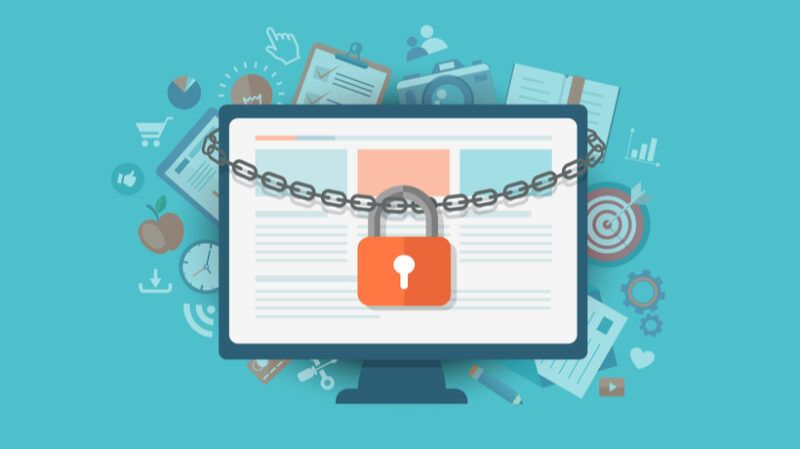

Risks Of Copyright Infringement
When posting intellectual property to the public view, we always have to consider the risks. Since most of the data is now stored on the web, with free access, there are high chances of content infringement and piracy. While the majority of search engines and platforms are trying their best to offer content security for the owners of intellectual property, there are still unfortunate incidents that might be missed by the security technology.
This is most likely to happen in the online education market. Professors and institutions create personalized online courses with multifunctioning content and share access with all the course participants. In fact, the course moderators sometimes give learners access to downloading learning materials exclusively for the improvement of a learning curve. Nevertheless, sometimes such content can be effortlessly copied and shared on other platforms, freely and omitting the author. Well, if you post an online course and give access to a large number of people, you need to be aware of the severe damage it might bring to you, in a form of copyright infringement.
How Copyright Infringement May Influence The Content Owner
1. Loss Of Traffic
The cloned course may be visited by some of your site’s visitors. The problem is that search engines don’t always recognize the original source. As a result, they may show searchers a number of items with comparable material so the CTR and traffic volume of the original website may decrease.
2. Reader Loyalty Dwindles
Users will not waste time investigating, thus they will most likely choose between your content and the plagiarized content at random. This can cause credibility loss in the long run, especially if the website with the copyright infringement appears to be better visualized, or if it gets more views/comments.
3. Search Engine Security Measures
Original content websites are sometimes subjected to search screening, while imitation sites go unpunished [1]. In this case, search engines can ban your course rather than that of the perpetrators, and you’ll have to fight for your content or just update it.
4. Long-Term Proceedings
Even if you were lucky and managed to find the perpetrator, you’ll have to provide proof that you are the course owner and there will be extensive altercations on the next steps required to resolve such an incident.
Sometimes plagiarists are too lazy to deal with minor issues, so your greatest chance to prevent plagiarism is to create difficulties in downloading or copying. But some of them can be persistent in their desire for particular content, hence online course creators just have to accept this fact and do something about it. Happily, there are numerous means to prevent plagiarism, or the use of intellectual property without permission, depending on the format of the content (text/video/image/audio). Let’s take a look at the best ones for each format.
Ways To Secure Various Forms Of Content
Probably if your content was targeted for plagiarism, you did a great job when creating it. Of course, it’s praise you wished for, but still, try to take a positive from the situation. Nevertheless, you shouldn’t tolerate copyright infringement even when it’s a compliment. Therefore, here are the means to secure your online courses from being stolen, plus approaches that can prove that you are the initial owner of the intellectual property.
1. Protecting Texts
- Information regarding copied content is hidden in a separate block
A part of the text provides a reference to the original source. A plagiarist can duplicate it without even realizing that they copied the text with the site’s or company’s name in it. - Disable text selection highlighting using CSS
Even if script execution is disabled, this will work [2]. However, if the perpetrator opens the page’s code and copies the text from there, this method will fail. - Disable copying to the clipboard
This functionality depends on the tools you use to build your site. Each of them has particular configurations for this. - Special pinging services
You can utilize one of several pinging services that send automated messages about new posts on your platform. - Strong social media presence
If you work on the marketing of your online course, there won’t be questions about who is the owner of the content, since your social media history will support you. And also if your course is well-known, there is less chance that someone will just copy-paste it. In such a scenario, this person will face major problems, in comparison to stealing from an unknown source.
2. Securing Images
- Watermarks
This is the most common way that is utilized everywhere. But it’s essential to know that since this is the most popular approach, there are lots of tools to remove watermarks from images. So, now it’s not the most secure one. - Empty file when downloading
This is done using coding and development skills. Hopefully, the perpetrator won’t seek a method to hack the image, and will just go for any other option more easily available on the web. - Copying is restricted via the context menu
This can be accomplished by modifying JavaScript, CSS, jQuery, or CMS plug-ins. - Images with digital marks
This option is not to prevent plagiarism but to prove afterward that it was your content (using the information regarding the camera used to take the shots, as well as the date, time, and place). - Use the IPTC metadata to prove ownership
The camera may fill in basic IPTC metadata, such as copyright information, while it shoots photographs. IPTC metadata updating is possible in a number of software applications, including Adobe Photoshop, Bridge, and Lightroom. - Creating a list of anchors made up of distinct text fragments
These should be under 100 characters long. This technique speeds up content indexing. Be aware that the thief can just make a screenshot of an image, and this method’s security is in doubt. - Separating images into bits
You can chop an image into numerous portions and then use a code to link them together. But again, screenshots are your enemy in this case.
3. Video Preservation
- Watermarks
This most popular technique is also applied to videos. It is effective even when screenshots or screen recordings are made. - Hidden link for download
You can just find a player that keeps the video download link hidden from users and plug-ins. But your video won’t be secured from screen recording. - DRM encryption.
The only solid way to protect video courses is to use DRM encryption. Even if it is downloaded, the plagiarizer will require an encryption key in order to play it.
What Won’t Secure Your Content?
While not all the means above really work for eLearning content security, all of them are somewhat effective with regard to content infringement. Nevertheless, there are several ways that people still utilize in order to secure their intellectual property that aren’t robust at all, for example, using built-in scripts to prevent content duplication. Only the most oblivious plagiarists are unaware that they can simply view the page’s source code or disable scripts in the browser when dealing with websites that have built-in scripts.
The other example is when the course owner just puts a link to the source at the end of the text. As a result, when the copied text fragment is pasted into the text field, the indicated link is located at the end of it. This makes it easy to detect and delete sources if needed. So this method isn’t worth your time.
Summing Up
You won’t be able to totally prevent your content from being duplicated, but that doesn’t mean you shouldn’t attempt it. Just try to combine the techniques mentioned above in order to create a perfect synergy for your particular online course. If you find a balance between visual and tech-specific methods, your course will be secure enough. But don’t forget about loyal learners. Leave them the possibility to download materials for learning purposes, since this is a major part of the learning process which you can’t cut out.